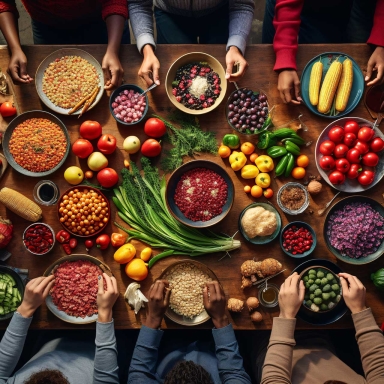Migrating to New Client Portal - Existing Clients
Migrating to New Client PortalHow to feed a diverse group of eaters at holiday get-togethers

One of the best parts of the holiday season is sharing your home with friends and family at fun and festive get-togethers. One of the most challenging parts of the holiday season is trying to figure out what to serve everyone. When Lilly is a vegetarian, Charlie is a vegan, Sue needs to eat gluten-free, Mike is allergic to peanuts and Jody wouldn’t touch a raw vegetable to save her life, how can you possibly cater to everyone?
Feeding a group of diverse eaters can be…interesting, let’s say. But it can also be a fun challenge. Ensuring that everyone’s dietary needs and preferences are respected will make your get-togethers more inclusive and enjoyable for all. And you don’t have to struggle with difficult or exotic recipes to do it, as the following tips and ideas will prove.
Tips for serving foods everyone can enjoy
Communicate. Before the event, be sure to communicate with all your guests to understand any specific requirements or severe allergies. Don’t hesitate to ask them for hints on what works for them.
Read labels. Many packaged foods contain dairy, nuts, gluten or non-vegetarian ingredients. As you shop for your event, check the ingredient labels to be sure.
Offer some pre-packaged snacks. Luckily, there are lots of pre-packaged snacks, like gluten-free crackers and vegan chips, that make it easy to provide safe options for guests with dietary restrictions.
Avoid cross-contamination. Be careful not to create an opportunity to cross-contaminate foods (e.g., use separate cooking utensils, pots and pans for gluten-free cooking; don’t use the same tongs to grill meat and vegetarian burgers).
Swap out some basic ingredients. When you use olive oil instead of butter on your vegetables, your vegan guests or those with dairy allergies can eat them. If you use vegetable stock in meat-free dishes, instead of beef or chicken stock, more people can enjoy them.
Set up the food buffet-style. A buffet makes it easy for guests to choose what suits their dietary needs. Just be sure to arrange the foods in a way that minimizes the risk of cross-contamination (e.g., place all gluten-free options at the beginning of the line).
Create DIY stations. Consider having a “make your own” station, such as a taco bar or a sundae assembly line, where guests can put together their own meals or desserts according to their preferences and needs. Leaving the toppings on the side means everyone, including those with food allergies, can pick and choose what works for them.
Label everything clearly. Use labels to indicate dishes that are vegan, gluten-free, nut-free, etc., to help guests navigate the table easily.
Tips for foods to serve
A menu that caters to various dietary needs can still be festive and delicious. Here are some inclusive food ideas for your holiday parties. We’ve included links to a few recipes, but if you’re not a cook or baker, don’t worry; most bakeries, grocery stores and restaurants offer gluten-free and other restricted dietary options these days.
Appetizers
Vegetable platter with a variety of dips like hummus, guacamole and a vegan, nut-free pesto.
Stuffed mushrooms filled with a mixture of quinoa, onions and herbs.
Bruschetta with tomato, basil and balsamic glaze, served with both regular and gluten-free bread.
Main course
Stuffed acorn squash filled with a mixture of quinoa, cranberries and chopped veggies.
Lentil loaf with gluten-free breadcrumbs or oats; serve with a side of vegan gravy.
Traditional meat option, like roasted turkey or ham, for your omnivore guests (make sure it’s prepared and served separately to prevent cross-contamination).
Side dishes
Mashed potatoes prepared with plant-based milk and vegan butter. You could add roasted garlic for extra flavor.
Root vegetables like carrots, parsnips and beets, roasted with olive oil and herbs.
Gluten-free stuffing made with gluten-free bread, celery, onions and vegetable broth.
Salads
Winter salad with kale, roasted Brussels sprouts, pomegranate seeds and a light vinaigrette.
Caprese salad skewers are great for vegetarians, with cherry tomatoes, mozzarella cheese and fresh basil leaves.
Desserts
A fruit platter is a safe and healthy option that’s naturally gluten-free and vegan.
Vegan and gluten-free pies like pumpkin or apple can be made with a gluten-free crust and vegan filling.
Chocolate fondue with a variety of dippable items like fruits, marshmallows (vegan if needed) and gluten-free pretzels.
Breads and spreads
Assorted bread baskets with gluten-free and regular bread and cracker options and vegan chips.
Spreads that include vegan butter, jam and a dairy-free cheese alternative.
Beverages
Alternative drinks for those who don’t drink alcohol, like fruit-infused water. You could also set up a separate non-alcoholic bar stocked with juice, sparkling water and other flavorings and garnishes.
Hot chocolate bar with both dairy and non-dairy milk options and a variety of toppings like whipped cream, marshmallows and candy canes. Ensure some are vegan and gluten-free.
Tea and coffee with a variety of milk options, including dairy-free ones like almond milk, oat milk or soy milk.
By taking advantage of these tips and thoughtfully curating a menu with a mix of the above options, you can ensure that all your guests—whatever their dietary preferences or restrictions—will have a joyful and satisfying holiday feast.


